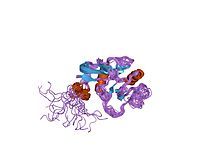Link domain
| Link domain | |||||||||
|---|---|---|---|---|---|---|---|---|---|

Structure of the hyaluronan-binding domain of human CD44
|
|||||||||
| Identifiers | |||||||||
| Symbol | LINK | ||||||||
| Pfam | PF00193 | ||||||||
| Pfam clan | CL0056 | ||||||||
| InterPro | IPR000538 | ||||||||
| SMART | SM00445 | ||||||||
| PROSITE | PDOC00955 | ||||||||
| SCOP | 1o7b | ||||||||
| SUPERFAMILY | 1o7b | ||||||||
| CDD | cd01102 | ||||||||
|
|||||||||
| Available protein structures: | |
|---|---|
| Pfam | structures |
| PDB | RCSB PDB; PDBe; PDBj |
| PDBsum | structure summary |
A Link domain or Link module, also known as Xlink domain (X for extracellular), is a protein domain that binds to hyaluronic acid. It is important in blood cell migration and apoptosis. The link domain is found in some extracellular proteins in vertebrates such as the hyalectans. It appears to be involved in extracellular matrix assembly and stability, cell adhesion, and migration.
The structure has been shown to consist of two alpha helices and two antiparallel beta sheets arranged around a large hydrophobic core similar to that of C-type lectin. This domain contains four conserved cysteines involved in two disulphide bonds. The link domain has also been termed HABM (hyaluronic acid binding module) and PTR (proteoglycan tandem repeat).
Proteins which contain the link domain include:
This article incorporates text from the public domain Pfam and InterPro IPR000538
...
Wikipedia
